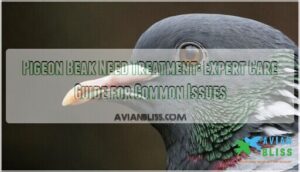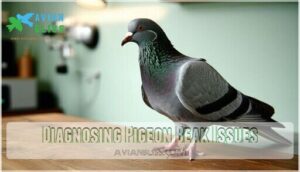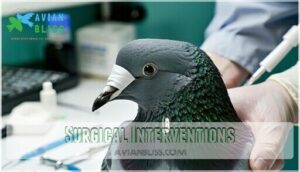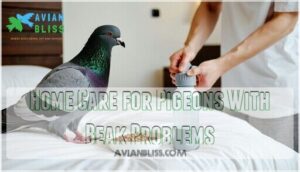This site is supported by our readers. We may earn a commission, at no cost to you, if you purchase through links.

Common issues include pigeon pox lesions, canker growths, fungal infections, and trauma from accidents.
Watch for difficulty eating, visible swelling, discharge, or changes in beak color and texture.
While mild cases might respond to supportive care like soft foods and clean water, serious conditions require veterinary attention.
Some pigeons need regular beak trimming due to overgrowth, while others develop infections that demand targeted medication.
The key is recognizing symptoms early—a healthy beak means a healthy bird.
Smart prevention strategies and proper home care can make all the difference in your feathered friend’s recovery.
Table Of Contents
- Key Takeaways
- Understanding Pigeon Beak Health
- Common Pigeon Beak Diseases and Conditions
- Signs of Beak Problems in Pigeons
- Diagnosing Pigeon Beak Issues
- Treatment Options for Pigeon Beak Diseases
- Home Care for Pigeons With Beak Problems
- Preventing Pigeon Beak Diseases
- When to Seek Veterinary Care
- Long-term Management of Pigeon Beak Health
- Frequently Asked Questions (FAQs)
- Do pigeons need their beaks trimmed?
- How do you treat a pigeon with a broken beak?
- What is the beak disease in pigeons?
- What is a deformed beak on a pigeon?
- How to treat a pigeon with a broken beak?
- What is the disease on pigeons beaks?
- How do you treat pigeon pox at home?
- How do you treat a pigeon’s infected beak?
- What happens if a pigeon has an infected beak?
- How do you treat Pigeon pox?
- Conclusion
Key Takeaways
- You’ll spot beak problems early by watching for difficulty eating, visible swelling, discharge, or changes in beak color and texture—these warning signs demand immediate attention before complications develop.
- You can’t treat serious conditions at home since diseases like pigeon pox, canker, and fungal infections require professional veterinary care with specific medications like antiviral drugs or antibiotics.
- You’ll need to modify feeding techniques by using shallow dishes, softening food with water, and providing puréed diets to help pigeons with beak injuries eat properly during recovery.
- You should focus on prevention through proper nutrition, clean environments, regular health monitoring, and vaccination protocols rather than waiting to treat advanced beak diseases.
Understanding Pigeon Beak Health
Understanding your pigeon’s beak health starts with recognizing proper Beak Anatomy and Beak Functionality.
The beak’s continuous Keratin Care and Beak Growth facilitate efficient food grasping and preening abilities.
Proper Pigeon Nutrition supports healthy development, while regular monitoring prevents common pigeon beak problems.
Watch for misalignment or unusual growths that signal underlying issues. Beak trimming may be necessary to maintain proper shape.
With attentive pigeon beak health monitoring and timely pigeon beak treatment, you’ll prevent potential beak infection and keep your bird thriving.
Common Pigeon Beak Diseases and Conditions
Several diseases and conditions can affect your pigeon’s beak, ranging from viral infections to traumatic injuries.
Understanding these common issues helps you recognize problems early and seek appropriate treatment before complications develop.
Pigeon Pox
Pigeon pox presents as warty growths on your bird’s beak, creating significant health challenges.
These warty growths signal serious viral infection requiring immediate isolation and veterinary care.
This viral infection spreads through mosquito bites and direct contact, making disease prevention critical for flock health.
When managing pigeon pox affecting beak areas:
- Apply topical antiseptics like povidone-iodine to prevent secondary bacterial infections
- Isolate affected birds immediately to stop virus transmission to healthy pigeons
- Provide soft foods since beak lesions make normal feeding difficult
- Monitor breathing as severe cases can obstruct airways
Pigeon vaccination remains your best defense against this persistent virus that survives in dried scabs for months.
Understanding avian pox symptoms is essential for effective management and treatment of the disease.
Canker
While pigeon pox affects external surfaces, canker strikes internally where Trichomonas gallinae creates yellowish plaques in your bird’s mouth and throat.
This microscopic parasite spreads through contaminated water and food, with 80% of pigeons carrying it.
Canker symptoms include difficulty swallowing and weight loss.
Water management is essential in preventing the spread of this disease.
Your avian veterinarian will prescribe metronidazole or ronidazole for effective canker medication treatment.
Fungal Infections
Through damp conditions and poor hygiene, fungal infections like Aspergillosis and Candidiasis can wreak havoc on your pigeon’s beak.
These opportunistic pathogens cause beak malformation, whitish plaques, and eating difficulties.
Antifungal therapies including nystatin prove effective when combined with environmental control measures. Early intervention prevents deeper tissue invasion and chronic damage.
Trauma and Injuries
Your pigeon’s beak faces constant hazards that can result in beak fractures, dislocations, or complete avulsion from collisions, fights, or accidents.
These avian trauma cases require immediate emergency care – apply styptic powder to control bleeding and seek veterinary attention for proper beak repair.
Implementing injury prevention measures like safe housing protects against future beak injury complications.
Understanding beak health issues is essential for providing the best care for your pigeon’s beak.
Signs of Beak Problems in Pigeons
Recognizing pigeon beak problems requires careful observation of your bird’s behavior and physical appearance.
Watch for these warning signs that indicate your pigeon needs immediate attention:
- Visible beak deformity or malformation – crooked growth, unusual curves, or asymmetrical development
- Beak fractures or lesions – cracks, chips, bleeding, or open wounds on the beak surface
- Keratin issues and infection signs – discoloration, swelling, discharge, or abnormal texture changes
You’ll notice feeding difficulties when beak infection affects your pigeon’s ability to grasp seeds properly.
Pigeon beak health deteriorates when birds can’t preen effectively or show reluctance to eat.
Proper pigeon beak care involves monitoring for overgrowth requiring trimming, unusual bumps, or persistent scratching at the beak area, which often signals underlying pigeon beak problems.
Diagnosing Pigeon Beak Issues
How do you accurately diagnose pigeon beak problems? Start with Visual Examination to identify cracks, swelling, or discoloration.
Use gentle Beak Palpation to detect tenderness or abnormalities. Beak Inspection should include observing feeding patterns and behavior changes.
Diagnostic Tests like swabs or blood work may be necessary for pigeon beak infection confirmation. Radiography helps identify fractures in severe cases.
Look for signs of beak deformity or growth irregularities. Professional evaluation guarantees accurate diagnosis and appropriate pigeon beak treatment recommendations.
Accurate assessment requires understanding of beak injury treatment to address the underlying causes effectively.
Treatment Options for Pigeon Beak Diseases
When your pigeon shows signs of beak disease, you’ll need to act quickly with the right treatment approach.
The specific treatment depends on the underlying condition, ranging from topical medications for infections to surgical repair for severe trauma.
Medication and Topical Treatments
Once you’ve identified the problem, effective treatment becomes your next step.
Your veterinarian will recommend specific medications based on the diagnosis:
- Antiviral medications like Zovirax target pigeon pox infections directly
- Topical ointments containing chlorhexidine help manage infected lesions
- Antifungal treatments such as nystatin combat fungal overgrowth
For bacterial infections, antibiotics like enrofloxacin or metronidazole work systemically.
Beak creams and wound care products aid healing while preventing secondary infections.
Your vet might prescribe combination treatments for complex cases involving multiple pathogens.
Understanding antiviral drug options is essential for effective treatment.
Supportive Care
Beyond medication, your pigeon needs thorough supportive care for ideal recovery.
Nutrition advice centers on providing balanced diets rich in vitamins A and D to strengthen immune function.
Stress reduction through quiet environments accelerates healing, while environmental enrichment with varied perches supports natural beak wear.
Health monitoring involves daily observation for changes in eating patterns or beak appearance, and regular beak trimming may be necessary during recovery periods.
Surgical Interventions
Sometimes your pigeon’s beak problems require more than medication—surgical intervention becomes necessary.
When medication isn’t enough, skilled surgical repair can restore your pigeon’s beak function completely.
Avian surgery specialists perform several procedures:
- Beak repair for fractures using pins or plates
- Surgical trimming to correct severe overgrowth
- Beak reconstruction after trauma or tumor removal
- Fracture fixation for complex breaks
- Prosthetic attachments when natural healing fails
These procedures restore function when conservative treatments fail.
Post-operative care includes soft diets and specialized perches during healing.
- Your pigeon deserves the chance to eat normally again
- Watching them struggle with feeding breaks your heart
- Expert surgical care can restore their quality of life
- Recovery means seeing your bird’s personality return
- Professional intervention prevents further complications
Home Care for Pigeons With Beak Problems
When your pigeon’s beak needs treatment, proper home care becomes essential for recovery and comfort.
You’ll need to master specialized feeding techniques, maintain strict hygiene protocols, and create an environment that supports healing while preventing further complications, which involves understanding the importance of complete concepts in care.
Feeding Techniques
Feeding pigeons with beak problems requires adaptive techniques to guarantee proper nutrition.
Use shallow, wide dishes that allow scooping rather than pecking, accommodating beak alignment issues. Soften seeds and pellets with water to reduce strain on compromised beaks during seed cracking.
Monitor eating habits closely—birds may struggle with food sorting or develop inefficient foraging strategies. Consider syringe feeding for severe cases, using soft-tipped syringes to prevent further trauma.
Implement beak feeding techniques with puréed diets for easier consumption. Always provide fresh water at beak level to minimize effort during drinking.
Properly designed pigeon feeding dishes can greatly facilitate the feeding process for pigeons with beak issues.
Hygiene and Cleaning
Anyone can maintain proper beak hygiene with consistent daily care. Clean your pigeon’s beak gently using warm saline solution to prevent beak infection and support pigeon beak health.
Regular use of a beak cleaning solution is essential for maintaining beak health.
Essential beak hygiene and cleaning practices:
- Beak Sanitizing: Use diluted antiseptic solution daily to remove debris and bacteria
- Water Quality: Provide fresh, clean water changed every 12 hours to prevent contamination
- Feather Cleaning: Wipe surrounding feathers to eliminate trapped food particles and discharge
- Cage Disinfection: Sanitize perches and feeding areas weekly using bird-safe disinfectants
Environmental Modifications
After establishing proper beak hygiene and cleaning protocols, you’ll need to modify your pigeon’s environment to support healing and prevent further complications.
Creating ideal beak environmental modifications requires attention to these key areas:
- Habitat Design: Install soft perches and rounded feeding stations to minimize beak trauma during daily activities
- Air Quality: Maintain proper ventilation and humidity levels to prevent respiratory issues that affect beak health
- Water Purification: Provide filtered water sources to reduce bacterial contamination and support overall wellness
- Noise Reduction: Create quiet zones that minimize stress-related behaviors like excessive pecking or scratching
- Sanitation Practices: Implement daily cleaning routines for food dishes and perches to maintain beak cleanliness
These beak environmental impacts directly influence recovery outcomes and long-term pigeon beak health maintenance. Proper beak care techniques are essential for preventing complications and ensuring optimal health.
Preventing Pigeon Beak Diseases
Prevention beats treatment in the context of pigeon beak health. Start with nutrition tips that include balanced pigeon feed, fresh fruits, and vegetables. Your healthy environment should feature clean water, proper ventilation, and regular disinfection. Beak hygiene improves with conditioning perches and cuttlebones that naturally wear down keratin buildup.
Preventive measures work best when you combine vaccination protocols with quarantine procedures for new birds. Monitor your flock daily for early signs of beak infection or pigeon beak problems.
| Prevention Strategy | Implementation | Frequency |
|---|---|---|
| Vaccination protocols | Poxvirus immunity | Annual boosters |
| Beak trimming | Professional assessment | As needed |
| Health monitoring | Visual inspection | Daily checks |
| Quarantine new birds | Isolation period | 30 days minimum |
| Environmental cleaning | Disinfection routine | Weekly deep clean |
These beak disease prevention strategies protect your pigeons from costly pigeon beak treatment down the road.
When to Seek Veterinary Care
Beyond routine care, certain situations demand immediate veterinary guidance from an avian veterinarian. Emergency care becomes essential when you notice acute beak injuries like fractures, bleeding, or sudden inability to eat.
Urgent treatment is critical for:
- Severe swelling or discharge indicating advanced beak infection
- Rapid weight loss exceeding 5% within a week
- Persistent lesions lasting beyond seven days despite home care
Medical intervention shouldn’t wait when feeding difficulties arise or systemic symptoms like lethargy appear. Professional pigeon beak repair addresses complex pigeon beak problems that home remedies can’t resolve. Early pigeon beak treatment prevents complications and improves outcomes substantially.
For severe injuries, finding an avian vet expert is vital for proper diagnosis and care.
Long-term Management of Pigeon Beak Health
Consistent beak monitoring every 2-4 weeks helps you catch issues early. Watch for asymmetry, discoloration, or overgrowth that signals trouble ahead.
Beak nutrition matters—supplement with calcium-rich cuttlebone and vitamin D3 for strong keratin care. Professional beak trimming every 2-3 months prevents complications, but never attempt this yourself.
Pigeon grooming perches naturally maintain beak length through daily wear. Address pigeon beak problems promptly to avoid recurrence.
Regular veterinary check-ups reduce advanced interventions by 30%. Remember, beak health depends on proper diet, clean environments, and stress management. Your diligence today prevents major pigeon beak treatment needs tomorrow.
Frequently Asked Questions (FAQs)
Do pigeons need their beaks trimmed?
Have you ever wondered why some pigeons struggle with eating?
Most pigeons don’t need regular beak trimming since their beaks naturally wear down through daily activities like foraging and preening.
However, birds with deformities, injuries, or overgrowth may require professional trimming to maintain proper function and prevent feeding difficulties.
How do you treat a pigeon with a broken beak?
Immediately stabilize the broken beak with gentle pressure to control bleeding. Clean the wound with saline solution, then seek emergency veterinary care for proper splinting and infection prevention.
What is the beak disease in pigeons?
Common beak diseases in pigeons include pigeon pox, canker, and fungal infections.
You’ll spot growths, swelling, or discharge that can permanently disfigure your bird’s beak if left untreated, requiring immediate veterinary care.
What is a deformed beak on a pigeon?
A deformed beak occurs when your pigeon’s bill grows abnormally due to trauma, infections like pox or canker, nutritional deficiencies, or genetic factors, affecting their ability to eat properly.
How to treat a pigeon with a broken beak?
Beak fractures aren’t always fatal – many pigeons recover with proper care.
First, control bleeding with gentle pressure using clean gauze.
Contact an avian veterinarian immediately for proper assessment and treatment planning to prevent complications.
What is the disease on pigeons beaks?
Several diseases can affect your pigeon’s beak, including pigeon pox (causing growths), canker (Trichomonas infection), and fungal infections like Aspergillosis. You’ll notice lesions, swelling, or discharge requiring immediate veterinary care.
How do you treat pigeon pox at home?
Roughly 60% of urban pigeons develop pox lesions during outbreaks, making home care essential.
You can’t truly cure pigeon pox at home since it’s viral, but you’ll support healing by maintaining clean conditions, providing nutritious food, and isolating affected birds until lesions naturally dry up and fall off.
How do you treat a pigeon’s infected beak?
Clean the infected area with warm saline solution, then apply veterinarian-recommended antibiotic ointment.
Provide nutritious food and fresh water.
Monitor closely for worsening symptoms, and seek professional veterinary care for severe infections or persistent problems.
What happens if a pigeon has an infected beak?
If you ignore an infected pigeon beak, you’ll watch your bird struggle to eat, lose weight, and potentially develop life-threatening systemic infections that spread throughout their body.
How do you treat Pigeon pox?
Like a stubborn weed that needs careful attention, pigeon pox requires veterinary treatment with antiviral medications like Zovirax, proper wound care, and maintaining clean living conditions to prevent secondary infections.
Conclusion
Ignoring a pigeon’s beak problems could literally mean the difference between life and death for your feathered companion.
When your pigeon beak needs treatment, swift action prevents minor issues from becoming major health crises.
You’ve learned to identify warning signs, understand treatment options, and provide proper supportive care.
Remember that early intervention, proper nutrition, and maintaining clean environments are your best defenses against serious complications.
Don’t hesitate to consult an avian veterinarian when symptoms persist or worsen.
- https://stevecreek.com/avian-keratin-disorder-understanding-beak-abnormalities-in-birds/
- https://www.pigeon-aid.sirtobyservices.com/ailments-injuries/overgrown-beak/
- https://www.thebirdclinic.com/beak-reconstructive-surgery
- https://www.gardenwildlifehealth.org/portfolio/beak-abnormalities/
- https://www.petassure.com/new-newsletters/bird-beaks-disorders-and-diseases/












